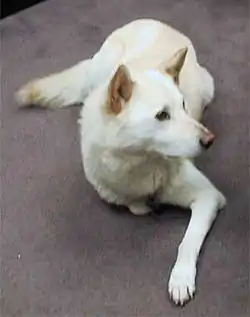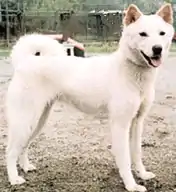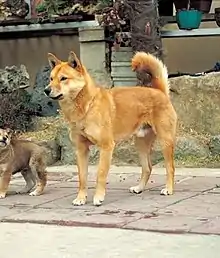Korean Jindo
The Korean Jindo (진돗개) is a breed of hunting dog that originated on Jindo Island in South Korea. Brought to the United States with South Korean immigrants, it is celebrated in its native land for its strong loyalty and bravery. The Jindo breed became recognized by the United Kennel Club on January 1, 1998[1] and by the Fédération Cynologique Internationale in 2005.[2][3]
| Korean Jindo | |||||||||||||||||||||||||||||
|---|---|---|---|---|---|---|---|---|---|---|---|---|---|---|---|---|---|---|---|---|---|---|---|---|---|---|---|---|---|
 A white Jindo | |||||||||||||||||||||||||||||
| Other names | Jindo Chindo Jindo Gae JindoGae | ||||||||||||||||||||||||||||
| Origin | Jindo Island, South Korea | ||||||||||||||||||||||||||||
| |||||||||||||||||||||||||||||
| |||||||||||||||||||||||||||||
| Dog (domestic dog) | |||||||||||||||||||||||||||||
| Korean name | |
| Hangul | 진돗개 |
|---|---|
| Revised Romanization | Jindotgae |
| McCune–Reischauer | Chindotkae |
Description
Appearance
Jindos are double-coated spitz-type dogs. Distinguishing the Jindo breed from mongrel and other breeds is often done by close examination of cranial and facial features and by analyzing the proportion of the head to the body. In addition, the breed exhibits sexual dimorphism with females having more angular heads than males.[4] The keen and alert appearance of the Jindo gives the impression of intelligence, strength, loyalty, and agility. Other features include forward-pointing upright ears and a double coat.
Body
Korean Jindo owners have traditionally divided Jindos into two body types:
- Tonggol or Gyeopgae: This type is more muscular and stocky with the Korean National Dog Association (KNDA) recognizing an equal proportion of height at the withers to length (10:10). The depth of chest is approximately equal to one-half the height at the withers. The loin is also typically shorter.
- Hudu or Hotgae: This type is more slender with a somewhat less depth of chest and a slightly longer loin. Moreover, other physical features tend to have an increased length, such as the ears, muzzle, and head. This results in an appearance that is longer than tall with the KNDA recommending a height at the withers to length ratio of 10:11.
The KNDA also recognizes a third body type called Gakgol which is a gradually emerging combination of the two traditional types, retaining the length of body of the Hudu and the depth of chest of the Tonggol.
In regards to the Jindo's body appearance, the United Kennel Club currently states, "The squarely built Jindo has a chest that is moderately deep but not too broad. At its deepest point the chest reaches to, or just above, the elbow. The brisket is well developed and the ribs are well sprung. The back is strong and straight and the loin is well muscled, taut, lean and narrower than the ribcage. There is considerable tuck up."[5]
Color
Jindos come in five colors:
- White (baekgu) - This color is actually an off-white or ivory shade with tan or light brown around the tips of the ears, the back of the hind legs, and the tip of the tail. Some whites may have a subtle tan stripe running from the head, down the top line, to the tail.
- Fawn (hwanggu) - The color of well-ripened wheat.
- Grey (heukgu) - This coat looks gray from a distance but is actually made up of individual white, black, and fawn colored hairs.
- Black and tan (Naenunbagi) - Black head and upper body with tan on the muzzle, belly, and paws, and an eye-shaped tan spot over each eye.
- Brindle (beulindeul) - Also known as "Tiger" pattern. Thin, dark brown or black stripes like a tiger's on a fawn base. These stripes appear at an early age.
Some Jindo Island residents value black, black/red, and red/white Jindos as good hunters. The United Kennel Club recognizes six different coat colors: white, red fawn, wolf grey, black, black and tan, and brindle (tiger pattern).[6]
Feet
The feet are of medium size, round in shape, with thick, strong tan pads. Nails are hard and may be black, cream or gray.
Gait
- The Jindo moves with strides of moderate length.
- It is a quick, light, elastic trot which enables the Jindo to travel quickly over any terrain.
- The forelegs and hind legs are carried straight forward, with neither elbows nor stifles turned in or out.
- At a normal walking speed, the Jindo tends to lower its head.
Head
- The top skull of an adult dog should be broad and rounded between the ears and free from wrinkles.
- The under jaw is well-developed and helps give a round or octagonal shape to the head when viewed from the front. Coarse hairs stand away from the cheeks.
- The ears are triangular and upright (leaning forward past vertical). The inside of the ears should be well-furred. Ears on puppies normally lie flat until they are past 5–6 months.
- The eyes are almond/round. They should be a shade of brown (a dark reddish-brown being preferred). Some dogs have light brown eyes but this color is not desirable. Jindos should not have blue eyes.
- The nose should be black on non-white dogs. White dogs may have mottled portions of tan or pink in the center of the nose.
- The muzzle is well proportioned without being bulky. The lips should be taut and black. The preferred color for the tongue is solid pink.
- The Jindo has a complete set of evenly spaced, white teeth with a scissors bite.
- Typically, males have larger heads and females have more fox-like features.
Height and weight
Desirable height at maturity, measured at the withers, ranges from 19½ to 21 inches (or 48 to 53 cm) for males and 18½ to 20 inches (or 45 to 50 cm) for females.[7]
Weight should be in proportion to the height, giving a well-muscled, lean appearance without being too light or too heavy. The typical weight range for a male Jindo in good condition is 40 to 60 pounds (18 to 27 kg); for a female, 35 to 55 pounds (16 to 25 kg).
Tail
The tail is thick and strong and set on at the end of the top line. The tail should be at least long enough to reach to the hock joint. The tail may be loosely curled over the back or carried over the back in a sickle position. The hair on the underside of the tail is thick, stiff, abundant, and twice as long as the coat on the shoulders, which causes the hair to fan outward when the tail is up.
Character

Jindo dogs are well known for their loyalty and gentle nature. Since Jindo dogs are active, they need proper living space, walks, care, and attention. There is also a clear perception of family hierarchy.[8]
They are of medium to high energy. If kept in a yard, the fencing must be at least 6 feet high due to their strong hind legs that enable them to jump high. Because Jindos are active and intelligent, they require frequent interaction with people or other dogs.

Loyalty
In 1993, a 7-year-old female Jindo named Baekgu (백구; 白狗; translated as a White Dog), raised by Park Bok-dan (박복단), an 83-year-old woman on Jindo Island, was sold to a new owner in the city of Daejeon which is located about 300 km (180 mi) away from the island. The dog escaped her new home and returned to her original owner, Park, after 7 months, haggard and exhausted. Baekgu remained with her original owner, who decided to keep the loyal dog, until the dog died of natural causes 7 years later. The story was a national sensation in South Korea and was made into cartoons, a TV documentary, and a children's storybook.[9] In 2004, Jindo County erected a statue of Baekgu in her hometown to honor the dog.[10]
Another Jindo, also named Baekgu, a 4-year-old male at the time who lived alone with his owner Park Wan-suh (박완서) residing on Jindo Island, did not eat anything and mourned for his dead owner for seven days after the owner died from a liver disease in June 2000.[11] According to Chosun Ilbo, the dog accompanied his dead owner for three days until other people came to find the body, followed the owner to his funeral, and came back home, not eating anything for four days. The Korean Jindo Dog Research Institute (진돗개 시험연구소) brought him under its care, but a person related to the Institute announced that the dog would not interact with anyone except for his feeder as of 2005.[12]
History
The jindos are now protected under the Cultural Properties Protection Act.[13]
In 1962, the Government of South Korea designated the Jindo as the 53rd 'Natural Treasure' (or translated as 'Natural Monument') (천연기념물; 天然記念物)[14] and passed the Jindo Preservation Ordinance. Because of the special status of the Jindo, it is very difficult to export purebred Jindo outside of Korea.[15] Jindos marched in the opening ceremonies of the 1988 Summer Olympic Games in Seoul, Korea. The United Kennel Club recognized the Jindo on January 1, 1998.
The Jindo Dogs Guild of Korea (Korean: 한국 진돗개 조합), as of 2008, issues certificates of pure Korean Jindo Dog, which specifies the registered number of the mother, sex, and birth date of the dog, as well as breeder's address and whether the dog is of purebred.[16]
The breed first appeared in the West in France and a small number have since been introduced to the United Kingdom and the United States. As of 2016, there were only two registered Jindos in the U.S.: one in the Los Angeles area and one in Seattle. There were 25 registered in the United Kingdom.[17]
Lineage
DNA analysis indicates that the Donggyeongi dog and the Korean Jindo separated from a common ancestor around 900 years ago.[18] A recent study on the genetic legacy of prehistoric dogs shows the Jindos and the New Guinea singing dog share some common ancestry.[19]
As police and military dogs
The Korean Army is known to use Jindos as guard dogs at major bases. Many Jindos do not take food from anyone other than their owners.[16]
In a 2009 interview with Korea Economic Daily (한국경제), Park Nam-sun (박남순), an expert search dog handler in South Korea, testified that Jindo dogs are not fit as rescue dogs and search dogs. It is because Jindo dogs' hunting instincts are too strong (they can forget their mission because of their hunting instincts), and they usually give their loyalty only to the first owner, while handlers of search dogs and rescue dogs can frequently change.[20]
In 2010, Son Min-suk (손민석), a member of Korean Security Forum, wrote that most of Korean military dogs were German Shepherds, and that Jindo dogs were not fit for military dogs as they were highly likely to escape their duties to find their first handlers who might be discharged from military services, or to come back to their original home.[21]
However, efforts to train Jindo dogs as search and rescue dogs continue. In October 2010, the Los Angeles Police Department announced their intent to evaluate the Jindo dog breed for law enforcement service, specifically for patrol and detection service. Four selected Jindo puppies would be distributed to LAPD and Glendale California Police Department to be trained as K9 units.[22] After a year of trying, the trainers found that the dogs did not have the right disposition for police work because they were too easily distracted and too eager to please their masters.[23]
See also
References
- United Kennel Club breed recognition. Archived 2011-06-03 at the Wayback Machine
- "FCI Breeds Nomenclature". Retrieved 8 December 2016.
- ""Jindo to host dog show to promote its own breed" press release by the Korean Culture and Information Service on September 25 2008".
- "Jindo - Appearance - Head". Retrieved 8 December 2016.
- Archived July 9, 2009, at the Wayback Machine
- "Breed Standards : Jindo - United Kennel Club (UKC)". www.ukcdogs.com.
- "Appearance of Jindo Dog and pictures by Jindo Dog Research and Testing Center".
- "한 번 빠지면 못 헤어 나오는 대한민국 토종견 '진돗개'의 매력 5". 인사이트 (in Korean). Retrieved 2019-03-27.
- Song, J. (1997). 돌아온 진돗개 백구 [Return of Baekgu the Jindo dog]. Seoul, Korea: Daegyo. ISBN 89-395-1413-0
- "네이버 :: 페이지를 찾을 수 없습니다". Archived from the original on 29 January 2013. Retrieved 8 December 2016.
- ""A moving stoy of Jindo dog" by Jindo Dog Research and Testing Center".
- "2005 Chosun Ilbo Article (2005년 조선일보 기사)". Retrieved 8 December 2016.
- History of Jindo Dog from Jindo Dog Research and Testing Center Archived 2011-07-22 at the Wayback Machine
- Jindo profile, Korean Cultural Heritage site
- "Dog fight: jingoism vs jindoism". 10 June 2008. Retrieved 8 December 2016.
- "소년한국:". Retrieved 8 December 2016.
- "Chew Valley Gazette". Retrieved 8 December 2016.
- The Genetic Origin of Short Tail in Endangered Korean Dog, DongGyeongi
- Bergström, Anders; Frantz, Laurent; Schmidt, Ryan; Ersmark, Erik; Lebrasseur, Ophelie; Girdland-Flink, Linus; Lin, Audrey T.; Storå, Jan; Sjögren, Karl-Göran; Anthony, David; Antipina, Ekaterina; Amiri, Sarieh; Bar-Oz, Guy; Bazaliiskii, Vladimir I.; Bulatović, Jelena; Brown, Dorcas; Carmagnini, Alberto; Davy, Tom; Fedorov, Sergey; Fiore, Ivana; Fulton, Deirdre; Germonpré, Mietje; Haile, James; Irving-Pease, Evan K.; Jamieson, Alexandra; Janssens, Luc; Kirillova, Irina; Horwitz, Liora Kolska; Kuzmanovic-Cvetković, Julka; et al. (2020). "Origins and genetic legacy of prehistoric dogs". Science. 370 (6516): 557–564. doi:10.1126/science.aba9572. S2CID 225956269. Inference from Figure 5.
- "[생생인터뷰] "한 주인만 섬기는 진돗개, 특수견으론 안 맞더라고요"". Retrieved 8 December 2016.
- 헤럴드경제. ""우리 군견 80% 셰퍼드…진도개는 탈영견 신세 될 것 뻔해"". Retrieved 8 December 2016.
- ""LAPD Metropolitan Division K-9 to Visit South Korea Collaborative Training and Evaluation of the Jindo Dog " from LAPD Headquarters : Nixle". 14 July 2011. Archived from the original on 14 July 2011.
- Glionna, James M., "LAPD finds South Korean Jindo dogs not up to snuff", Los Angeles Times November 13, 2011
External links
| Wikimedia Commons has media related to Korean Jindo. |